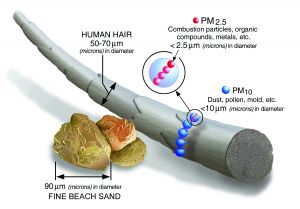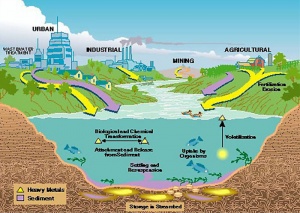Introduction

Particulate matter comparative size
Air pollution has recently been identified through statistical studies to be involved with abnormal development (See also smoking). With industrialisation and vehicle produced air pollution, it can consist of particulate matter, heavy metals and a range of chemicals.
Vehicle traffic air pollution can consist of several different components including: (elemental carbon, nitrogen dioxide, and ultrafine particle matter (10-700 nm).
In addition to their direct toxic effects, the potential reduction in fetal growth and long-term effects should also be considered. Much of the basic research relies on studies in various animal models of development and we should also consider the ongoing development of new industrial products in the environment with unknown or untested effects upon development.
Some Recent Findings
- Prenatal and early life exposures to ambient air pollution and development[1] "Residential proximity to major roadways, and prenatal exposures to particulate matter <2.5 μm (PM2.5) and ozone (O3) are linked to poor fetal outcomes but their relationship with childhood development is unclear. We investigated whether proximity to major roadways, or prenatal and early-life exposures to PM2.5 and O3 increase the risk of early developmental delays. 4089 singletons and 1016 twins born between 2008 and 2010.Proximity to major roadway was calculated using road network data from the NY Department of Transportation. Concentrations of PM2.5 and O3 estimated by the Environmental Protection Agency Downscaler models were spatiotemporally linked to each child's prenatal and early-life addresses incorporating residential history, and locations of maternal work and day-care. In this prospective cohort study, proximity to major roadway and prenatal/early-life exposures to PM2.5 and O3 were associated with developmental delays. While awaiting larger studies with personal air pollution assessment, efforts to minimize air pollution exposures during critical developmental windows may be warranted."
- Epigenetic marks of prenatal air pollution exposure found in multiple tissues relevant for child health[2] "Prenatal air pollution exposure has been linked to many adverse health conditions in the offspring. However, little is known about the mechanisms underlying these associations. Epigenetics may be one plausible biologic link. Here, we sought to identify site-specific and global DNA methylation (DNAm) changes, in developmentally relevant tissues, associated with prenatal exposure to nitrogen dioxide (NO2) and ozone (O3). Additionally, we assessed whether sex-specific changes in methylation exist and whether DNAm changes are consistently observed across tissues. RESULTS: We identified global and locus-specific changes in DNA methylation related to prenatal exposure to NO2 and O3 in 2 developmentally relevant tissues. Neonates with increased prenatal O3 exposure had lower aggregate levels of DNAm at CpGs located in open sea and shelf regions of the genome. We identified 6 DMRs associated with prenatal NO2 exposure, including 3 sex-specific. An additional 3 sex-specific DMRs were associated with prenatal O3 exposure levels. DMRs initially detected in cord blood samples (n = 4) showed consistent exposure-related changes in DNAm in placenta. However, the DMRs initially detected in placenta (n = 5) did not show DNAm differences in cord blood and, thus, they appear to be tissue-specific. CONCLUSIONS: We observed global, locus, and sex-specific methylation changes associated with prenatal NO2 and O3 exposures. Our findings support DNAm is a biologic target of prenatal air pollutant exposures and highlight epigenetic involvement in sex-specific differential susceptibility to environmental exposure effects in 2 developmentally relevant tissues." epigenetics
- The association between maternal exposure to ambient particulate matter of 2.5 μm or less during pregnancy and fetal congenital anomalies in Yinchuan, China: A population-based cohort study[3] "Few studies from western countries have linked prenatal exposure to ambient particulate matter <2.5 μm (PM2.5) with increased risk of congenital anomalies. However, the results are mixed. Particularly, evidence is limited for Chinese pregnant women. METHODS: In this retrospective cohort study, we matched the data of all pregnant women laboured in public hospitals during 2015-2016 in Yinchuan, a capital city of northwest China and the data of daily average PM2.5, nitrogen dioxide (NO2), sulphur dioxide (SO2) and ozone (O3) concentrations of the nearest monitor station. We calculated a time-dependent exposure over the entire pregnancy for each woman. We used a time varying Cox proportional hazards model to explore the association between PM2.5 exposure and the risk of congenital anomalies, after adjusting for individual confounders and other pollutants. RESULTS: A total of 39,386 singleton live births were included in the study, and 530 (1.35%) were with congenital anomalies. An increase of 10 μg/m3 in PM2.5 exposure over the entire pregnancy was significantly associated with increased risk of congenital anomalies, with hazard ratio (HR) of 1.35 [95% confidence interval (95%CI): 1.16, 1.58]. For subtype analyses, PM2.5 exposure exhibited a significant association with cardiac anomalies and other unclassifiable anomalies, with HRs of 1.60 (95%CI: 1.24, 2.08) and 1.42 (95%CI: 1.07, 1.89), respectively. The impacts of PM2.5 exposure on orofacial anomalies and musculoskeletal anomalies were not significant. CONCLUSION: Our results indicate high concentration of PM2.5 could increase the risk of congenital anomalies among Chinese, especially for cardiac anomalies. Self-protective measures involving reducing PM2.5 pollution exposure during pregnancy as well as environmental policies aiming to restrict PM2.5 emission could be helpful to reduce the burden of cognitional anomalies."
- Air Pollution Exposure During Fetal Life, Brain Morphology, and Cognitive Function in School-Age Children[4] "Air pollution exposure during fetal life has been related to impaired child neurodevelopment, but it is unclear if brain structural alterations underlie this association. The authors assessed whether air pollution exposure during fetal life alters brain morphology and whether these alterations mediate the association between air pollution exposure during fetal life and cognitive function in school-age children. We used data from a population-based birth cohort set up in Rotterdam, The Netherlands (2002-2006). Residential levels of air pollution during the entire fetal period were calculated using land-use regression models. Structural neuroimaging and cognitive function were performed at 6 to 10 years of age (n = 783). Mean fine particle levels were 20.2 μg/m3 (range, 16.8-28.1 μg/m3). CONCLUSIONS: Exposure to fine particles during fetal life was related to child brain structural alterations of the cerebral cortex, and these alterations partially mediated the association between exposure to fine particles during fetal life and impaired child inhibitory control. Such cognitive impairment at early ages could have significant long-term consequences."
- Association between traffic-related air pollution in schools and cognitive development in primary school children: a prospective cohort study[5] "Air pollution is a suspected developmental neurotoxicant. Many schools are located in close proximity to busy roads, and traffic air pollution peaks when children are at school. We aimed to assess whether exposure of children in primary school to traffic-related air pollutants is associated with impaired cognitive development. METHODS AND FINDINGS: We conducted a prospective study of children (n = 2,715, aged 7 to 10 y) from 39 schools in Barcelona (Catalonia, Spain) exposed to high and low traffic-related air pollution, paired by school socioeconomic index; children were tested four times (i.e., to assess the 12-mo developmental trajectories) via computerized tests (n = 10,112). CONCLUSIONS: Children attending schools with higher traffic-related air pollution had a smaller improvement in cognitive development."
|
| More recent papers
|
|
This table allows an automated computer search of the external PubMed database using the listed "Search term" text link.
- This search now requires a manual link as the original PubMed extension has been disabled.
- The displayed list of references do not reflect any editorial selection of material based on content or relevance.
- References also appear on this list based upon the date of the actual page viewing.
References listed on the rest of the content page and the associated discussion page (listed under the publication year sub-headings) do include some editorial selection based upon both relevance and availability.
More? References | Discussion Page | Journal Searches | 2019 References | 2020 References
Search term: Air Pollution Teratology
|
| Older Papers
|
| These papers originally appeared in the Some Recent Findings table, but as that list grew in length have now been shuffled down to this collapsible table.
See also the Discussion Page for other references listed by year and References on this current page.
|
Particulate Matter
Fine ambient particulate matter consists of small particles of 2.5 μm or less in size. While ultrafine particle matter occurs in the range of 10-700 nm.
Asthma
Flow limitation during tidal expiration in early life significantly associated with the development of physician-diagnosed asthma by the age of 2 years. Infants with abnormal lung function soon after birth may have a genetic predisposition to asthma or other airway abnormalities that predict the risk of subsequent lower respiratory tract illness. Asthma phenotypes have a number of different classifications; allergic asthma, intrinsic or nonallergic asthma, infectious asthma, and aspirin-exacerbated asthma, and environmental exposures (occupational agents, smoking, air pollution, cold dry air).[6]
A recent Dutch PIAMA birth cohort study has shown that air pollution exposure is associated with a lower lung function in schoolchildren.[7]
References
- ↑ Ha S, Yeung E, Bell E, Insaf T, Ghassabian A, Bell G, Muscatiello N & Mendola P. (2019). Prenatal and early life exposures to ambient air pollution and development. Environ. Res. , 174, 170-175. PMID: 30979514 DOI.
- ↑ Ladd-Acosta C, Feinberg JI, Brown SC, Lurmann FW, Croen LA, Hertz-Picciotto I, Newschaffer CJ, Feinberg AP, Fallin MD & Volk HE. (2019). Epigenetic marks of prenatal air pollution exposure found in multiple tissues relevant for child health. Environ Int , 126, 363-376. PMID: 30826615 DOI.
- ↑ Liu C, Li Q, Yan L, Wang H, Yu J, Tang J, Yao H, Li S, Zhang Y & Guo Y. (2019). The association between maternal exposure to ambient particulate matter of 2.5 μm or less during pregnancy and fetal congenital anomalies in Yinchuan, China: A population-based cohort study. Environ Int , 122, 316-321. PMID: 30455103 DOI.
- ↑ Guxens M, Lubczyńska MJ, Muetzel RL, Dalmau-Bueno A, Jaddoe VWV, Hoek G, van der Lugt A, Verhulst FC, White T, Brunekreef B, Tiemeier H & El Marroun H. (2018). Air Pollution Exposure During Fetal Life, Brain Morphology, and Cognitive Function in School-Age Children. Biol. Psychiatry , 84, 295-303. PMID: 29530279 DOI.
- ↑ Sunyer J, Esnaola M, Alvarez-Pedrerol M, Forns J, Rivas I, López-Vicente M, Suades-González E, Foraster M, Garcia-Esteban R, Basagaña X, Viana M, Cirach M, Moreno T, Alastuey A, Sebastian-Galles N, Nieuwenhuijsen M & Querol X. (2015). Association between traffic-related air pollution in schools and cognitive development in primary school children: a prospective cohort study. PLoS Med. , 12, e1001792. PMID: 25734425 DOI.
- ↑ Hekking PP & Bel EH. (2014). Developing and emerging clinical asthma phenotypes. J Allergy Clin Immunol Pract , 2, 671-80; quiz 681. PMID: 25439356 DOI.
- ↑ Finke I, de Jongste JC, Smit HA, Wijga AH, Koppelman GH, Vonk J, Brunekreef B & Gehring U. (2018). Air pollution and airway resistance at age 8 years - the PIAMA birth cohort study. Environ Health , 17, 61. PMID: 30016982 DOI.
Reviews
Articles
Ha S, Yeung E, Bell E, Insaf T, Ghassabian A, Bell G, Muscatiello N & Mendola P. (2019). Prenatal and early life exposures to ambient air pollution and development. Environ. Res. , 174, 170-175. PMID: 30979514 DOI.
Ladd-Acosta C, Feinberg JI, Brown SC, Lurmann FW, Croen LA, Hertz-Picciotto I, Newschaffer CJ, Feinberg AP, Fallin MD & Volk HE. (2019). Epigenetic marks of prenatal air pollution exposure found in multiple tissues relevant for child health. Environ Int , 126, 363-376. PMID: 30826615 DOI.
Search Pubmed
External Links
External Links Notice - The dynamic nature of the internet may mean that some of these listed links may no longer function. If the link no longer works search the web with the link text or name. Links to any external commercial sites are provided for information purposes only and should never be considered an endorsement. UNSW Embryology is provided as an educational resource with no clinical information or commercial affiliation.
Glossary Links
- Glossary: A | B | C | D | E | F | G | H | I | J | K | L | M | N | O | P | Q | R | S | T | U | V | W | X | Y | Z | Numbers | Symbols | Term Link
Cite this page: Hill, M.A. (2024, April 28) Embryology Abnormal Development - Air Pollution. Retrieved from https://embryology.med.unsw.edu.au/embryology/index.php/Abnormal_Development_-_Air_Pollution
- What Links Here?
- © Dr Mark Hill 2024, UNSW Embryology ISBN: 978 0 7334 2609 4 - UNSW CRICOS Provider Code No. 00098G



